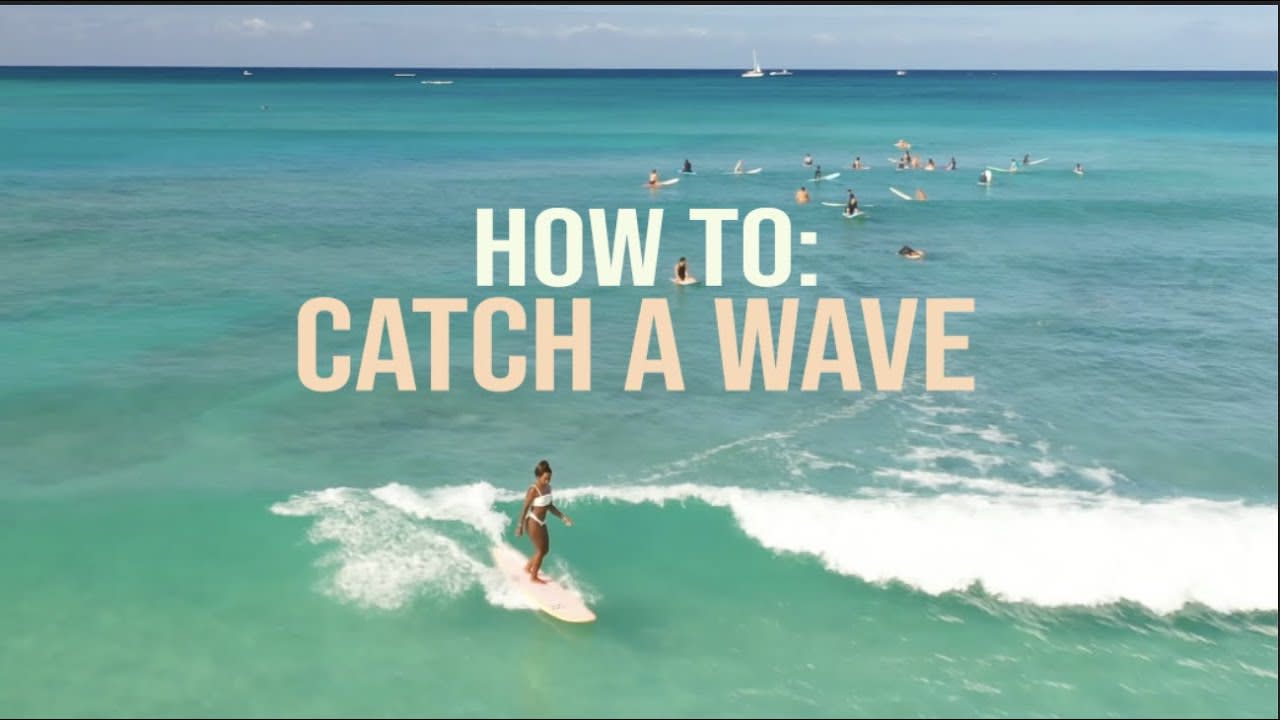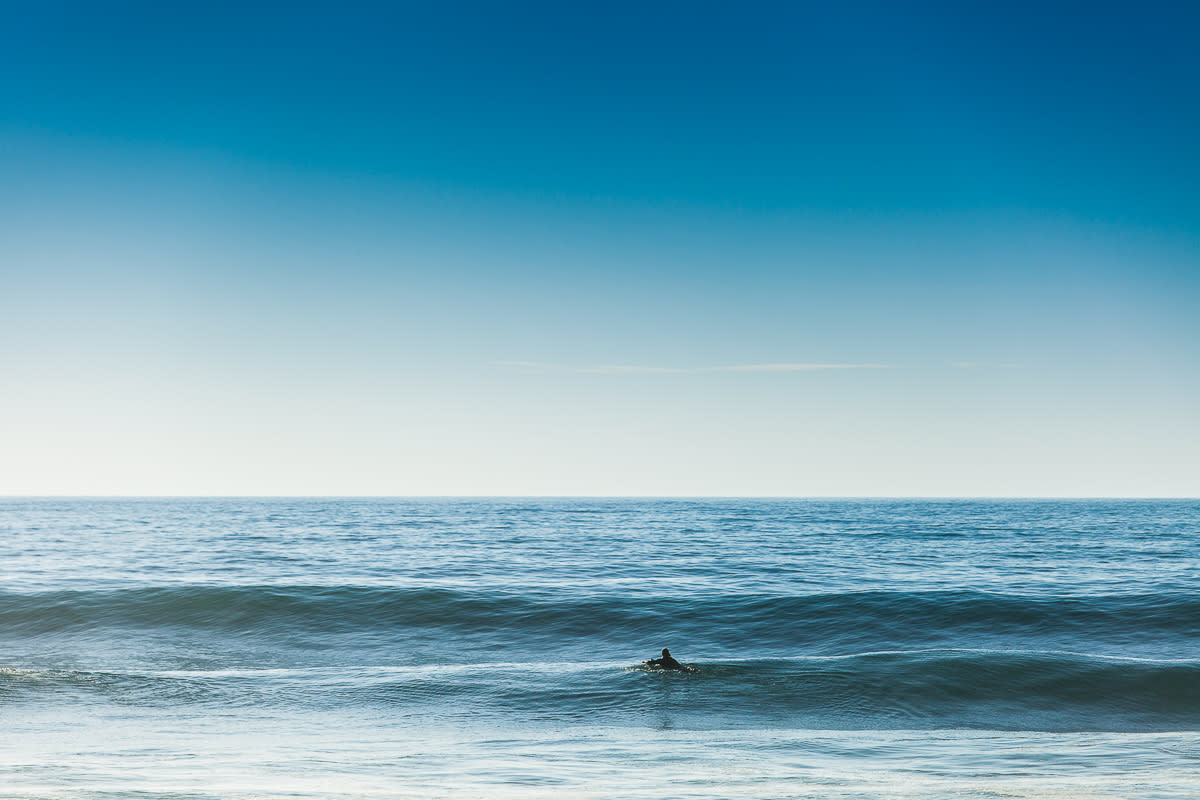
Så fångar du en obruten våg
June 30, 2025Känner du dig osäker på hur du kan identifiera en surfbar våg? Den här steg-för-steg guiden hjälper dig att förstå de olika stegen av en våg och hur du ska tajma din pop-up.
Surfing är ett livslångt äventyr och en fantastisk livsstil. Att bli en dela av den här sporten kommer troligtvis börja med att du bokar en flygbiljett till något av surfparadisen runt om i världen. Och helt plötsligt är det din första dag på ett surfcamp.
En viktig del i att lära sig surfa är att veta när det är dags att fånga en våg, därför ska vi gå igenom att hitta rätt tajming och hur vågens olika steg ser ut.
När du ska lära dig surfa bör du starta i grunt vatten och fånga vågor som redan är brutna, i så kallat “vitvatten”. När vågorna redan är brutna är det lättare med tajming och du lär dig grunderna utan större konsekvenser. När du börjat få till tekniken på brädan är det dags att paddla ut till lineupen. Då är det bra att ha en instruktör med sig när man ska fånga sin första gröna, obrutna våg.
Länk test
VIDEO
How To Catch A Wave | How To Surf

Vad är en obruten våg?
En grön våg är en våg som ännu inte börjat bryta, en så kallad obruten våg. Det är en speciell känsla att fånga sin första gröna våg – en känsla som inte kan jämföras med något annat! I början är det bra att ha med sig en instruktör som kan hjälpa dig med position, val av våg och tajming.
Men hur gör man när man sen ska surfa på egen hand? Allt handlar om hur mycket tid man lägger ner i vattnet. Lapoint finns här för att hjälpa dig med teorin och fysiken bakom hur en våg bryter och hur vi ska behärska den. Vi kommer här förklara på ett så enkelt sätt som möjligt hur vågen byggs upp, hur den bryter och hur du ska tajma den bäst.
STEG A
Är detta en våg eller inte?

Vi vet alla om citatet ”everything in life comes in waves”. Vilket också stämmer i havet, men här kommer vågorna faktiskt i fyra olika steg. Vi ger de olika stegen namn: steg A, steg B, steg C och steg D.
Steg A är det första stegen då vågen bara är en liten puckel som kommer glidandes in mot stranden. I det här steget kan man inte fånga vågen då den inte har tillräckligt med lutning. Att tilläga är att ju större bräda du har desto tidigare kan du fånga en våg. Detta för att det är enklare att få upp farten och matcha vågens fart så du kan fånga den.
STEG B
GO HARD OR GO HOME — HUR MAN SURFAR EN GRÖN VÅG?

För att fånga vågor behöver du parera dem i steg B. Det är steget där den tidigare “lilla bulan” av vatten (steg A) har blivit starkare. Energin är här redo att släppas ut. Steg B är när en våg är idealisk att fånga. Om du kan matcha vågens hastighet tills du känner att du glider på vattenytan är du redo att utnyttja denna kraft på bästa sätt och kan då fånga vågen.
Notera: En våg kan antingen bryta till höger eller vänster. Precis innan du gör din pop-up kan du titta till höger och vänster för att se vilken riktning du ska surfa för att följa vågens så kallade “pocket”. Kontrollera också om det finns andra surfare som redan är på vågen.
Kolla gärna in vårt inlägg för regler i lineupen för att lära dig mer om surfetikett.
För alla som precis har börjat fånga gröna vågor eller kämpar med att få rätt timing: Heja dig! Att vara på rätt plats OCH komma upp i tid samtidigt på din surfbräda är en av de svåraste momenten att bemästra. Det kommer att ta tid att lära sig men du KOMMER att ha det ögonblicket när den lilla switchen i huvudet slår om. Du kommer att börja känna att du måste vara där, på rätt plats och i rätt tid. Du kommer också att börja se vid vilken hastighet vågorna bryter.
När du kommer till en ny surfspot, eller till och med en som du redan känner till, rekommenderar vi att du sitter och tittar på de inkommande vågorna ett tag innan du går i vattnet med din surfbräda.
Det är inte bara viktigt för att planera var du ska sitta och se vart/om det finns rip currents och hur de rör sig i vattnet, klippor eller andra hinder som möjligtvis kan påverka – utan också för att kontrollera vågornas hastighet och vilken riktning de bryter. (Om detta lät som ett främmande språk för dig, oroa dig inte. Du kommer att lära dig allt detta under dina surflektioner).
STEG C
DETTA KAN BLI ETT RISKFYLLT ÖGONBLICK
Det här stadiet är när vågen bryter och frigör all sin energi med full kraft. Medan det är ett ögonblick av ära för vissa kan det för andra sluta som en omgång i tvättmaskinen med huvudet först och brädan flygandes upp i luften. Vågorna färdas flera kilometer innan de når stranden. Resans längd på vågorna har stor betydelse i hur kraftfulla de är när de bryter mot stranden. Ju längre vågorna har färdats desto kraftfullare och desto mer energi byggs upp under tiden.
Ögonblicket som vågen bryter är ögonblicket all energi frigörs. Om du inte redan står på surfbrädan vid detta steg kommer den frigjorda kraften att mer eller mindre hamna över dig. Det är en risk att ta, men det är också adrenalinkicken som får oss att återvända för mer varje gång.
STEG D
PERFEKTA VÅGOR FÖR NYBÖRJARE SOM VILL TRÄNA PÅ SIN POP-UP INNAN DE PADDLAR UT TILL EN LINEUP
Efter att vågen har brutit kommer vitvattnet att röra sig mot stranden. Det här är den del av vågen som du har eller kommer att lära dig surfa på. Den har mycket mindre kraft än en obruten (grön) våg och du kan stå upp när som helst vilket gör det till det enklaste sättet att lära sig tekniken.
Förresten! Vågor som redan är i ett brutet stadium är utmärkt att ta sig med hela vägen in till strandkanten om man vill ta den snabba vägen in från en lineup. Det är superkul och går mycket snabbare än att paddla tillbaka till stranden!
Vi hoppas att den här guiden har hjälpt dig att identifiera de olika stadierna av en inkommande våg. Här är några tips att avsluta med:
Försök att hålla dig lugn när du är i vattnet, trots att det oftast är enklare sagt än gjort.
Vänta tillräckligt länge innan du paddlar när du ser en inkommande våg.
Undvik att hamna för nära stranden och få vågen över dig när den är i steg C.
Kom ihåg att ta några kraftfulla paddle strokes och se om du glider med vågen innan du försöker ställa dig upp och fånga vågen helt.
I slutändan är det inget som slår övning! Hastigheten och formen på varje våg, samt hur den bryter beror på platsen där du surfar och havets förhållanden. Det kommer att ta tid att lära sig att anpassa sig till var och en av dessa förhållanden. Lycka till!
NEWSLETTER
Håll dig uppdaterad, prenumerera på vårt nyhetsbrev

Maren Gimnes
Maren is a copywriter and content creator with a true passion for exploring the beautiful planet we call home. Her love for the ocean and salty days brought her to Lapoint, where she’s been living the digital nomad life and visiting our surf camps in all corners of the world. Maren aims to inspire others to pursue the surf lifestyle, to never miss a sunset and to follow their dreams.
Senaste blogginläggen
June 30, 2025

